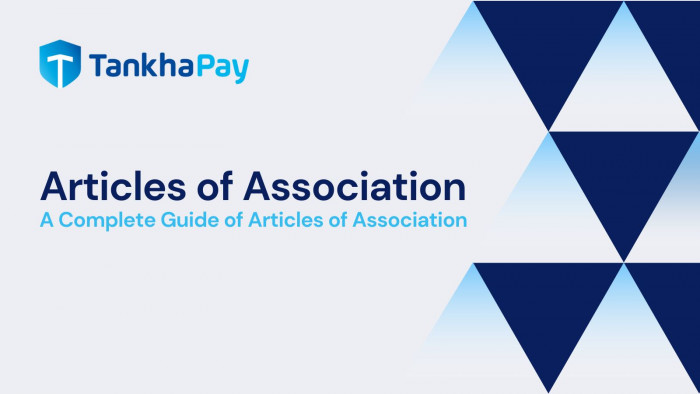The Articles of Association (AoA) serves as the foundational charter document, playing a pivotal role in establishing the legal identity of a company across various global jurisdictions, including the United Kingdom, Europe, and China.
This regulatory masterpiece not only delineates the purpose and operational framework of a company but also adheres to the minimum content requirements set by regulatory authorities in each jurisdiction, known as articles. It lays the groundwork for conducting commercial activities as a distinct legal entity. However, it's worth noting that companies can go beyond these basics, tailoring their AoA to align with unique circumstances and aspirations.
This article will discuss the Articles of Association in detail and explore their significance and dynamic role in shaping the legal aspects of companies worldwide.
What is the Articles of Association (AoA)?
Articles of Association are pivotal documents for effective business governance, essentially serving as a contractual agreement between a company and its shareholders.
Described as the 'user guide' for a business, these articles intricately detail the organisational structure and lay out the procedures for shareholder meetings, akin to a roadmap guiding the company's operations.
Functioning as a set of rules agreed upon by shareholders and directors, the articles meticulously outline the managerial and administrative framework of the business. They play a vital role in defining the rights of shareholders and providing clarity on various aspects, including the issuance of shares, dividend distribution, and the extent of voting rights conferred upon shareholders.
Beyond organisational formalities, the articles are crucial in establishing the company's legal identity, clearly stating its name and forming the bedrock of the company's constitution.
Accessible as a public record at the company's registration office, these articles serve as a comprehensive guide, shaping the operational landscape and ensuring transparency in the company's dealings.
What is the Purpose of Articles of Association (AoA)?
Companies embark on the journey of incorporation for diverse reasons, often necessitating the submission of various documents to ensure compliance with regulations. Among these, the Articles of Association emerge as a pivotal cornerstone, serving as the principal source for authorities to evaluate and confer upon a company its distinct legal identity, separate from its stakeholders.
Fondly referred to as the "Articles," this comprehensive document encompasses critical details such as the company's name, legal form, purpose, capital structure, corporate governance, administration of corporate records, and other essential terms defining its existence.
Interestingly, jurisdictions may adopt different nomenclatures for this foundational document, referring to it as the Memorandum of Association, Articles of Incorporation (AoI), Memorandum of Incorporation, Constitution, or Articles of Organization, among other titles. Regardless of the name, the Articles of Association collectively stand as the compass guiding a company's legal presence and operational framework.
Can a company change its Articles of Association?
Indeed, a company has the flexibility to modify its Articles of Association under certain circumstances. This need may arise due to changes in the legal landscape or directives from regulatory authorities.
To initiate such a change, the company typically convenes a general meeting where the directors endorse a statement notifying shareholders about the necessity to amend the articles of association. Subsequently, a meeting is convened with shareholders to pass a special resolution, signifying their agreement to the proposed changes.
This process underscores the company's ability to adapt and align its governing documents with evolving legal requirements or external mandates, ensuring its continued compliance and effective operation.

Components of the Association
Company Name and Form of Business
To attain legal entity status, a company must possess a distinctive name, a crucial detail enshrined in the articles of association. The inclusion of an address ensures registration is linked to a specific legal location. Different jurisdictions may mandate suffixes like “Inc,” “Ltd,” or “Plc” to denote specific business structures, with restrictions on potentially confusing or offensive terms. While companies generally exist perpetually, articles may explicitly define their duration and cessation processes.
Purpose of the Company
The articles articulate the purpose of a company, whether for-profit, delivering stakeholder value, or non-profit, providing intangible societal benefits. Some jurisdictions permit general purpose statements like "management," while others require specific enterprise purposes, such as "operation and growth of a restaurant chain.
Capital Structure
For companies with share capital, the articles detail the organisational framework, often involving common shares and potentially other classes like preferred shares with distinct rights. Companies without share capital, such as non-profit entities, may be structured as companies limited by guarantee. The capital structure signifies the relationship with stakeholders, outlining how the company allocates stakes in exchange for support.
Corporate Governance
This section defines directors' roles and duties and outlines the rights and responsibilities of shareholders or members. Often dictated by jurisdictions, corporate governance rules highlight directors' primary responsibilities, considering the possibility of shareholding by entities beyond individuals. The articles may address directors' liability, indemnity, and decision-making processes and stipulate meeting frequencies, participation criteria, voting protocols, and quorums. Dispute resolution mechanisms and procedures for addressing contentious issues may also be outlined.
Administration of Corporate Records
Articles necessitate the maintenance of comprehensive records, including minutes of directors' and shareholders' meetings, financial records, and accounting documentation. Regulatory authorities may mandate regular submissions and retention, ensuring verifiable company existence beyond individual directors, owners, and members. This component serves as a critical aspect of compliance and transparency within the corporate framework.
Importance of a Company’s Articles of Association?
The AoA is super important, and there are multiple reasons why, let’s discuss some of them in detail below;
Foundational Statutory Documents: The Articles of Association rank among the most crucial statutory documents for a newly established company. Together with the memorandum of association, they form the legal backbone of the company's structure and operations.
Legal Requirement: In numerous countries, the articles, along with the memorandum of association, are obligatory documents for company formation. Compliance with these legal requirements is fundamental to the legitimacy and recognition of the company.
Significance in Investor Relations and Stock Market: Signed by the company secretary and directors, the articles play a pivotal role in investor relations and stock market dealings. They provide a comprehensive framework that guides the company's internal operations, offering clarity and assurance to stakeholders.
Goal Setting for the Organization: The articles serve as an effective platform to outline regular goals for the organisation. Incorporating strategic objectives and operational guidelines provides a roadmap for the company's growth and development.
Utility in Financial Transactions: Essential for practical financial matters, the articles may be required when establishing a company bank account or applying for business loans. Financial institutions often rely on these documents to understand the legal structure and governing principles of the company.
Official Company Recognition: The company does not attain official status until the articles of association have been properly filed. This filing is a critical step in the company's formal recognition, marking its establishment as a legitimate entity.
In essence, the Articles of Association are not merely paperwork; they are the legal blueprint shaping a company's identity, governance, and interactions with stakeholders. Their importance extends beyond regulatory compliance, influencing investor confidence, financial transactions, and the overall operational trajectory of the company.
Legal Effects of the Articles of Association
Binding Nature on the Company and Members: The Articles of Association serve as a binding contract between the company and its members. In the event of a breach by the company, members possess the legal right to take action to restrain the company's actions.
Enforcement of Financial Obligations: By signing the articles, members explicitly agree that any monies owed to the company constitute debts. The articles can be invoked as legal instruments to enforce payment, establishing a clear framework for financial transactions within the company.
Governing Member Relations: The articles play a crucial role in governing relationships between members. They stipulate how and when members should inform each other about their intention to transfer shares, providing a structured framework for member interactions and share transfers.
Limitations on Binding Outside Parties: While the articles create a binding agreement between the company and its members, they do not extend their binding nature to external parties who are not party to the agreement. Consequently, outside entities are not legally bound by the provisions outlined in the Articles of Association.
Limitations of Alteration in AoA
Modifications to a company's Articles of Association are subject to certain limitations to ensure legality, adherence to public policy, consistency with court orders, and avoidance of fraudulent activities. Additionally, alterations must not augment the liability of members. In essence, changes to the articles must comply with legal and ethical standards.
Articles of Association, serving as the agreed-upon rules between shareholders and directors, delineate the organisational and administrative structure of a business. They encapsulate vital information regarding shareholder rights and responsibilities. While a company possesses the authority to amend its Articles of Association, such modifications necessitate a special resolution mandating a majority vote by shareholders.
These articles play a pivotal role in guiding the company's operations, impacting investment decisions, and influencing activities in the stock market. They go beyond procedural details, extending to the framework for share transfers and other fiduciary duties within the company. Crucially, the Articles of Association form a binding legal document between shareholders and directors but do not impose obligations on external parties. This legal framework ensures transparency, governance, and the integrity of the company's internal operations.
FAQs About Articles of Association
What is AOA and MOA?
Ans - AOA (Articles of Association) and MOA (Memorandum of Association) are foundational documents that meticulously delineate a company's raison d'être, defining its objectives, rules, and internal management structures. These documents are indispensable, forming the bedrock of a company's constitution.
What is an example of an article of association?
Ans - An illustrative example within the Article of Association involves individuals formally expressing their commitment to acquiring a specific number of shares in the company's capital. This commitment is intricately tied to the provisions laid out in the MOA.
What is the content of the Articles of Association?
Ans - Articles of Association encapsulate a comprehensive array of details, ranging from pertinent company personnel information and stock offering amounts to specific guidelines regarding dividend distribution. Moreover, these articles delineate the regulatory framework guiding the company's day-to-day operations.
What are the Articles of Association for the Companies Act, 2013?
Ans - As per the Companies Act, 2013, Section 2(5), the Articles of Association constitute a meticulous document housing the intricate rules and regulations that intricately govern the management and operations of a company.
What is the major difference between MOA and AoA?
Ans - The Memorandum of Association (MOA) primarily serves as a comprehensive guide for company incorporation, laying down the necessary details. Conversely, the Articles of Association (AoA) delve into the internal management intricacies, detailing company objectives, and delineating the powers vested within.
Why is the AoA important?
Ans - The Articles of Association (AoA) play a pivotal role by defining the internal dynamics and relationships within a company. They elucidate the rights and liabilities of each member, ensuring that every facet of the company's activities aligns seamlessly with its predetermined scope and objectives.
Is AOA a public document?
Ans - Yes, according to Section 10 of the Companies Act, 2013, post-registration, both the Memorandum of Association (MOA) and Articles of Association (AOA) metamorphose into public documents. This transformation entails a binding commitment, wherein members are tethered to the company, and reciprocally, the company is bound to its members.
Where can I find a copy of a company's Articles of Association?
Ans - Companies are required to maintain a copy of their Articles of Association at their registered office address. Additionally, a copy should be accessible on public record at the company’s registration office.
Who is obligated to adhere to the Articles of Association?
Ans - The Articles of Association function as a contractual agreement between the company and its shareholders. This binding agreement can only be altered through a special resolution, necessitating agreement from at least 75% of shareholders.















